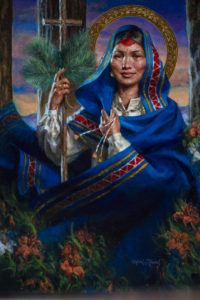
Herman Ray, a member of the Salt River-Pima Tribe, believes God sent St. Kateri Tekakwitha into his life at a time when he struggled with addiction. The first Native North American saint, he said, showed him he could be 100 percent Native and 100 percent Catholic.

Ray, a member of the Phoenix Inter-Tribal Kateri Circle, will be leading the St. Kateri Chaplet and Litany at the diocesan St. Kateri Tekakwitha Feast Day Celebration on Saturday, April 25 at St. Francis of Assisi Mission in Scottsdale.
The festivities will begin at 9 a.m. that day with the chaplet and litany, followed by a 10 a.m. Mass celebrated by Bishop Thomas J. Olmsted. After the Mass, the parish will provide a free lunch featuring Native food. The day will include traditional music, dancing, and authentic arts and crafts. The celebration will end with a blessing with a relic and a traveling statue of St. Kateri being placed in the parish. The feast day celebration rotates between the 11 Native American missions, and the statue stays at whichever mission hosts it.
St. Kateri Tekakwitha was born to an Algonquin mother and Mohawk chief in 1656 in what is now upstate New York. After her family died from a smallpox epidemic that left her face permanently scarred, she converted to Catholicism against her extended family’s wishes. Facing harassment in her village, she escaped to a settlement for Christian Natives in Canada, where she taught the faith to children and visited the sick and elderly. She died April 17, 1680.
“It’s been something really beautiful to find young women on the reservation devoted to Kateri,” said Dcn. Jim Trant, parish life coordinator for St. John the Baptist Parish in Laveen, which canonically includes four of the Native missions, including St. Francis.
“She was very much the servant … and a wonderful example of virtue, chastity, and poverty among her own people.”
Ray recalled that when he struggled with addiction, he’d find peace connecting with his Native culture in nature. He remembered falling to his knees and asking God for help. A few days later, his mother invited him to attend the national Tekakwitha Conference.
“That was the first time I heard of Kateri,” Ray said. He remembered seeing a statue of then-Blessed Kateri in the church during the closing Mass.
“This surprised me because I never thought I’d see a Native person in there,” said Ray, who before that point felt he had to leave his Native ways at home. “It was a Native Mass with drums and singing.”
Ray, who is now an active parishioner at St. Theresa in Phoenix, said he is often surprised to meet non-Native Americans who know of and have a devotion to her.
“St. Kateri is a very strong saint, and she’s not only for Native Americans, she’s for the whole Church,” he said. “She made such a big impact on my life so I was proud to share her story.”
[quote_box_center]
St. Kateri Tekakwitha
Feast Day Celebration
When: April 25, 9 a.m. Chaplet and Litany; 10 a.m. Mass with Bishop Olmsted, followed by festivities.
Where: 3090 N. Longmore, Scottsdale
Info: Deacon Jim Trant at (602) 354-2011 or jtrant@diocesephoenix.org
[/quote_box_center]





